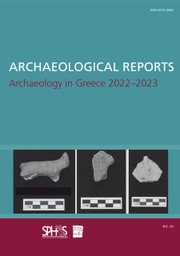No CrossRef data available.
Article contents
Recent Acquisitions of Greek, Roman and Cypriot Antiquities at the Fitzwilliam Museum 2001–2006
Published online by Cambridge University Press: 08 January 2010
Extract
The Fitzwilliam Museum, founded through the bequest of Richard, 7th Viscount Fitzwilliam of Merrion (1745–1816), is the principal museum and art gallery of the University of Cambridge. The Museum's collection of Greek, Roman and Cypriot antiquities grew steadily throughout the 19th and 20th centuries by gift, bequest, excavation and purchase, and is today one of the finest such collections in the United Kingdom outside London.
- Type
- Article
- Information
- Copyright
- Copyright © Authors, the Society for the Promotion of Hellenic Studies and the British School at Athens 2007
References
NOTES
1 Unpublished letter from Beazley, J.D., 27 January 1966, to Mr R.D. Phippen of Spink and Son, copy provided by vendor of cup.Google Scholar
2 Paralipomena 372–73, 25 ter.
3 Bochum, , Rühr Universität S 1213, N. Kunisch, Makron (Mainz 1997), fig. 1, pl. 57, no. 161.Google Scholar
4 Rome, Vatican, Beazley, J.D., Athenian Red-Figure Vase-Painters, ed. 2 (Oxford 1963) (ARV 2) 375,68. The sketch lines, noted by Robert Guy, are mentioned by Kunisch, Makron, 75.Google Scholar
5 For the Dokimasia Painter see ARV 2 412–15, 1649, Para 372–73, 512, Beazley Addenda 233–34 and for more recent bibliography D. Williams in CV British Museum 9, 61, 69; among this see especially Robertson, M., The Art of Vase Painting in Classical Athens (Cambridge 1992) 115–18.Google Scholar
6 GR.12.1955, ARV 2 381,178 (the glaux), Loan Ant. 103.18, ARV 2 402,12 (the Foundry Painter cup). A more detailed article on the Brygan vases at the Fitzwilliam Museum, including the new cup, is in preparation.
7 For the Athena Vescovali see Schürmann, W., ‘Die Typus der Athena Vescovali und seine Umbildungen’, Antike Plastik 27 (2000), 37–90.Google Scholar
8 For the Mantineia Base see Stewart, A., Greek Sculpture (Yale 1990), pls 492–94, discussed 177, 279. Stewart (and others) believes the base may be ascribed to the school or workshop of Praxiteles but not to Praxiteles himself.Google Scholar
9 For this argument see Altripp, I.E., ‘Zu den Athenatypen Rospigliosi und Vescovali’, Anz (1996), 83–94; the argument is accepted by Schürmann, op.cit. (n. 7). For the Nikopolis statue, Nikopolis Museum inv. 6, see Schürmann, 37–40, S 1, figs 1–5, pls 20–21.Google Scholar
10 See Schürmann, , op.cit. (n. 7).Google Scholar
11 For Charles Walston see Spivey, N., Oxford Dictionary of National Biography (Oxford 2004), 155.Google Scholar




